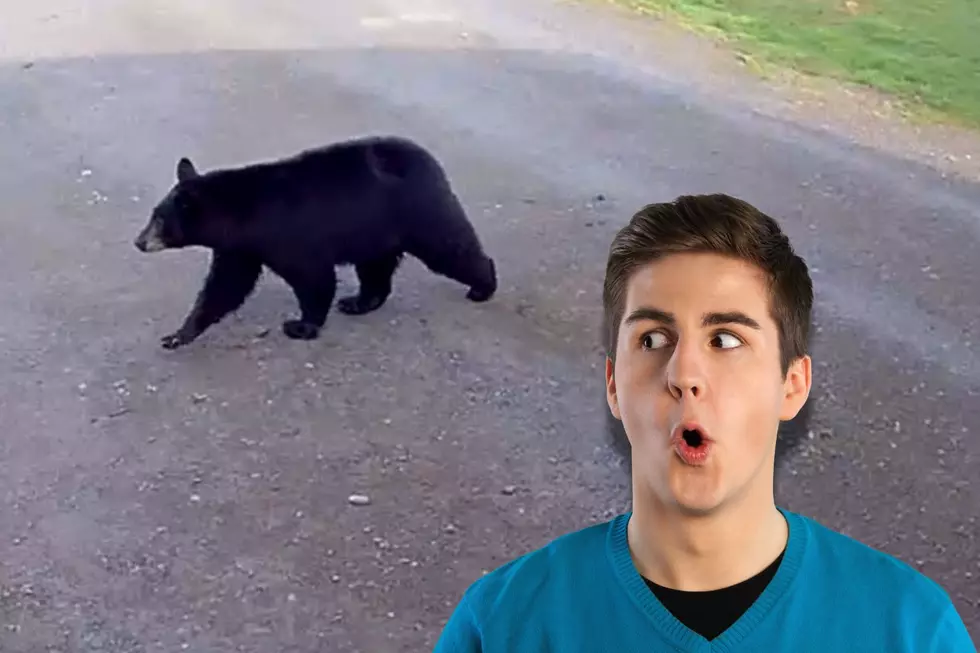
Beware! Black Bear Strolls Through Central New York Neighborhood
Beware! The bears are out of hibernation. One was seen strolling through a yard in Central New York.
There's a minimum of 6,000 to 8,000 bears in New York State and they've come out of hibernation and they're hungry.
Bears are curious animals and spend a great deal of time looking for food. And they are smart. Bears learn from experience. If they find food, they will be back.
Lee Center Bear
Lisa Davis has lived on Thomas Road in Lee Center for 30 years. In all that time, she's never seen a bear on her property. That is until this week.
"When my camera went off, I was getting ready to let my little dog out."
Thankfully Lisa checked her camera BEFORE letting the dog out. That's when she saw a black bear strolling across her driveway.
READ MORE: Close Encounters of the Bear Kind in Upstate New York
Where Are the Bears
Where are the bears in New York state?
50-60% inhabit the Adirondack region
30-35% inhabit the the Catskill region
10-15% inhabit the central-western region.
Bears are now well established in many other areas, including the Tug Hill, Hudson Valley, and across the Southern Tier.
READ MORE: Hiker's Terrifying Run-In With Bear in New York Mountains
Tips to Avoid Bears
The DEC has tips on what to do if you happen to run into a bear.
DO:
- Use noise to scare bears away: Yell, clap, or bang pots.
- Stay calm: Walk slowly and speak in a loud and calm voice.
- Leave slowly: Cautiously back away from the bear and leave the area.
- If a bear charges you: Stand your ground. If you have bear spray, dispense directly at the bear.
- If a bear makes contact with you: Fight back with anything at hand (knife, stick, rocks, or fists).
READ MORE: Teen Shoots First Bear & It's a Doozy at 485 Pounds
DON'T:
- Approach, surround, or corner a bear: Bears aggressively defend themselves when they feel threatened. Be especially cautious around cubs as mother bears are very protective.
- Run from a bear: They may chase.
- Throw your backpack or food at an approaching bear: This will only encourage bears to approach and "bully" you to get food. By teaching a bear to approach humans for food, you are endangering yourself, other campers/residents, and the bears.
READ MORE: You'll Bare-ly Believe How Close Hunter Gets to Bear in New York
To Avoid Bears Coming Onto Your Property:
- Take down bird feeders in April. Bird feed such as suet and seeds are a very strong attraction for bears, even if they can't reach them.
- Clean your grill. Turn the grill on high for several minutes after you are done cooking to burn residual odors.
- Lock up your trash. Garbage is extremely attractive to bears. It should always be kept in sealed garbage cans inside a building like a garage or shed. Anything with an odor can attract a bear.
- Do not feed your pets outside. Leftover food or even an empty dish can attract a bear.
- Do not have refrigerators or freezers outside or on porches. Bears can smell what is inside.

If You're Camping:
- Throw out all your trash and recyclables.
- Lock up your coolers and food. Store food in either the trunk of your car or in the cab of your truck. Keep windows shut and food and coolers out of sight.
- NEVER keep food, coolers, or scented items in your tent.
- Treat all toiletries as food items. Toiletry products are heavily scented and are as attractive to bears as food.
- Clean up after all meals immediately. Keep grills, pots, pans, cooking utensils, and wash basins clean when not in use.
- Do not put grease, garbage, plastic diapers, cans, bottles, or other refuse into the fireplace. These items do not properly burn and will attract bears with their odors.
- Always remember when exploring the wilderness - you're in their home. Be vigilant and stay safe.
Bear Destroys Vehicle in Search of Food
Gallery Credit: Credit - Polly McAdams
Bears from around the world
Gallery Credit: Randy Bogden, Getty Images
